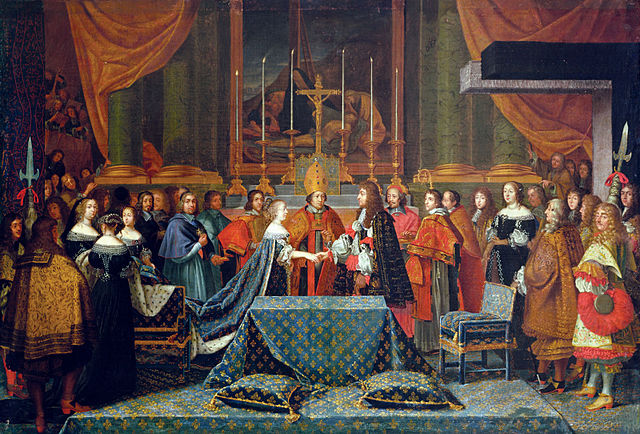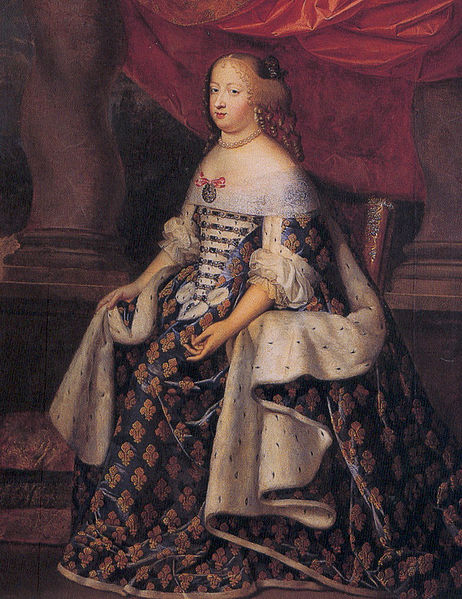Marie-Thérèse’s role as the queen of France and the wife of King Louis XIV was a precarious one, as she was used by the Spanish branch of the Habsburg dynasty to secure peace with France in the 17th century.
King Philip IV of Spain and Elisabeth of France welcomed the birth of their daughter Marie on September 10, 1638. The ambitions of Cardinal Jules Mazarin and Anne of Austria, the mother of King Louis XIV, to link the Bourbon dynasty to the Spanish branch of the Habsburg family extend back to 1646.
These two individuals wanted to create a marriage union between Louis XIV and Marie-Thérèse to stabilize relations between the French and Spanish governments as these two countries had been at war since 1635.
  |
There were complications with the proposed marriage between the two families because the Spanish Habsburg family did not want to give the Bourbon dynasty an opportunity to inherit any part of the Spanish Empire.
The Spanish court was also reluctant to allow the proposed marriage for it feared that the offspring of this union would create instability within the Spanish empire for rival claimants might seek to acquire various parts of the empire.
The anxiety of the Spanish court over this proposed marriage was relieved by the fact that Mariana of Austria, Philip IV’s second wife, gave birth to a son named Philip Prospero in 1657. Despite the fact that infant mortality rates were high in the 17th century, the birth of this son made Philip IV more agreeable to the marriage between Marie and Louis XIV. The marriage contract between Marie and Louis XIV was completed when the Treaty of the Pyrenees was finalized in 1659, and the two were married in June 1660.
 |
| Marriage of Louis XIV with Marie-Therese of Austria |
In accordance with the marriage contract, Marie abandoned any territorial claim she possessed to the Spanish Empire, and the Habsburg family had to provide 500,000 gold escudos for Marie’s dowry. Because of the financial weakness of the Spanish Empire, the Habsburg family could not pull together enough funds for the dowry. Despite the fact that Marie renounced her claims to the Spanish Empire, she was unable to do this on the part of her offspring, which Mazarin knew at the time of the wedding.
Mazarin also intended to use the inability of the Spanish government to pay the dowry as an excuse to ignore the fact that Marie renounced her inheritance to parts of the Spanish Empire. The French government used the failure of the Spanish government to pay the dowry as a justification to attack the Spanish Netherlands in 1667, resulting in the War of Devolution.
Marie was a devout woman who believed it was her responsibility to marry Louis XIV and to provide him with offspring to succeed him. Marie fulfilled these obligations to Louis XIV by providing him with a number of children, but only their son Louis survived into adulthood. She often prayed and had great admiration for priests but was also concerned for the Catholic religious community.
   |
Despite this extreme faith in her religion, she failed to possess a strong influence in the French government, probably as a result of her lack of education and her poor relationship with her husband. Marie’s relationship with Louis XIV was a strenuous one, but she continued to be loyal to him and fulfilled her obligations as a wife and queen.
Marie did exercise some influence over the French court as regent in 1672 when Louis XIV was fighting in Holland, but this was for a short period. Louis XIV had several mistresses, a well-known fact in the French court. Marie learned of many of these relationships, but it usually took time before she was made privy to this information.
Despite the fact that Marie had no major influence at the French court, her death on July 30, 1683, was properly mourned in France as she was given a state funeral. There is some degree of speculation that Marie might have been poisoned, but there is no firm evidence to support this claim.
Marie’s funerary rites possessed similarities to the funerary rites observed by Egyptian pharaohs, as her heart was removed from her body, placed in a silver box, and deposited in a chapel situated at Val-de-Grâce, while her intestines were also removed from her body and deposited in an urn.
